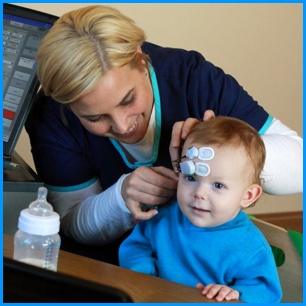On this page we cover:
- Audiogram (Behavioral Testing)
- Tympanogram
- Two Audiologist Audiogram
- Otoacoustic Emissions (OAE)
- Auditory Brainstem Response (ABR)
Audiogram (Behavioral Testing)
ENT for Children may recommend a hearing test or an audiogram for your child. All children that are being evaluated with a history of ear infections undergo hearing testing.
An audiogram is a formal hearing test that determines the type and degree of your child’s hearing impairment. Hearing test are completed in a soundproof booth on children down to the age of 6 months. The type of hearing test that will be administered to your child is based on your child’s age.

- Visual Reinforcement Audiometry: this type of hearing testing is completed on infants and very young children. Typically, the Audiologist will have your child sit on your lap during testing. During this test, your child’s Audiologist trains your child to turn their head towards the sounds. Their behaviors are reinforced by characters in the speakers that light up and move when your child turns their head to the sound to reward them for responding.
- Conditioned Play Audiometry: this type of hearing testing is completed on older children. During this test, your child’s Audiologist may play a game like dropping blocks in a bucket or putting pegs in a board when they hear the sounds
By the age of 5 years or older many children can complete a standard type of hearing test where they raise their hand or say “yes” in response to different tones.
Tympanogram

Tympanometry is a test that is used to examine the condition of a child’s eardrum and middle ear pressure. During the test your child’s Audiologist will gently place a probe in their ear canal. The device will change the air pressure in the ear canal in order measure the motion of your child’s eardrum and the volume of their ear canal. The reading will be displayed on a graph or tympanogram. The results of this test may suggest if there is fluid behind the eardrum, perforation of the eardrum or if the ear tubes are open and working correctly. This is not a hearing test. This test does not hurt, but some children do not like anything placed in their ears. This testing can be used for children of all ages.
Two Audiologist Audiogram
In order to put your child at ease, another Audiologist might accompany your child’s Audiologist during their audiogram. Typically, one of the Audiologists is inside the sound booth with your child and a second Audiologist running the audiometer outside of the sound booth. Both audiologists are working together to obtain a hearing test on your child. This type of testing is often recommended to obtain more ear specific information about your child’s hearing at younger ages than might be possible with one audiologist completing a hearing test.
Otoacoustic Emissions (OAE)
This test assesses the function of your child’s microscopic hair cells in their inner ear (the cochlea). A probe is gently placed into your child’s ear canal. The probe makes a soft sound and a super sensitive microphone within the probe is able to hear or detect the motion of the hair cells in your child’s cochlea. The child must be still and quiet for testing. This test does not hurt or cause any type of pain and can take as little as 2-3 minutes to complete if your child is still and quiet.
Auditory Brainstem Response (ABR)
An Auditory Brainstem Response (ABR) is a test that can be performed on newborns, infants, young children, and any child that is difficult-to-test. An ABR is a test that measures the electrical activity of your child’s inner ear, nerve that connects the inner ear to the brain and the first part of the brain known as the brainstem. Your child’s Audiologist at ENT for Children can interpret the tracings created by an ABR to establish at what level your infant or child should be able to hear.

To complete an ABR the Audiologist with place a set of stickers on your child’s forehead and behind the ear and a soft probe in their ear canal. The stickers are actually sensors that will detect the electrical activity of your child’s ear. Through the probe the Audiologist is able to deliver series of clicking sounds or tones. Different loudness levels and pitches are tested to determine the softest level that is audible to your child.
If your child will allow the stickers to stay on their forehead and behind the ear and the probe to remain in the ear canal, then the ABR can be completed awake (un-sedated). If not, then completing an ABR will require anesthesia (sedation). We can schedule an un-sedated ABR at our Coppell office. A sedated ABR is conducted under anesthesia at one of the surgery centers or hospitals where our physicians work.
If your child’s ABR is being completed un-sedated plan that the test will take a minimum of 45 minutes but often times takes longer. Testing is dependent on child’s cooperation and amount of information being obtained.
